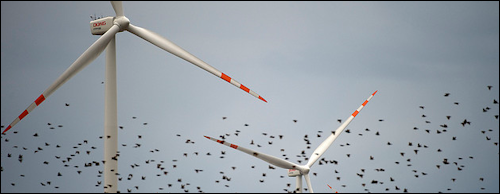Critics have long lambasted wind turbines for killing hundreds of thousands of birds and bats. Charlottesville-based Apex Clean Energy, which seeks to build a wind farm in Botetourt County north of Roanoke, has submitted a plan that it says will mitigate the worst effects of its 25 whirling turbine blades.
Apex would turn the turbines off from dawn to dusk every year between May 15 and Nov 14 when bats are foraging for food reports the Roanoke Times. But they would keep the turbines running when winds exceed 15 miles per hour or when the temperature drops below 38 degrees, conditions when bats tend not to fly.
“There are proven steps we can take to build and operate projects in an environmentally responsible manner,” said Apex spokesman Kevin Chandler.
Local conservation groups like the Rockbridge Area Conservation Council have opposed the wind farm on the grounds that the blades could cause the death of migratory songbirds, bats and perhaps golden eagles. Bird conservationists assert that wind turbines kill an estimated 600,000 birds a year in the United States and that the number could rise to two million with the deployment of more wind energy. Wind advocates say the number is miniscule compared to the 600 million or more killed each year by flying into buildings or hitting cars and trucks, but concerns remain an obstacle to widespread deployment of the turbines in Virginia.
Apex believes that damage to wildlife can be managed. The company hired professional birdwatchers to log the number of warblers, sandpipers, owls and other threatened or endangered species around its proposed wind farm. The surveys, conducted in consultation with the U.S. Fish and Wildlife Service and the Virginia Department of Game and Inland Fisheries, found that most North American birds would not be impacted. Eagles, hawks and falcons were not seen in large enough numbers to raise concerns.
But four endangered or threatened species — the northern long-eared bat, the Indiana bat, the tricolored bat and the little brown bat — were spotted during the surveys. In addition to restricting wind-turbine operations, Apex proposes to avoid cutting trees within five miles of the bats’ cave or within 150 feet of summer roosting trees for northern long-eared bats.
Bacon’s bottom line: Apex’s proposal is an idea worth exploring. On the one hand, it is desirable to minimize wildlife deaths, especially of rare and endangered species. Wind farms should be held to the same standard as pipelines, transmission lines and other energy projects when it comes to mitigating their impact on the environment. On the other hand, it appears that Apex has proposed a reasonable plan to minimize wildlife deaths. The company wisely initiated the wildlife surveys two years ago, long before the issue could become a deal-killer, and it has tailored a response to the local ecosystem. The solution isn’t perfect: Presumably a number of birds and bats still could die, and the company definitely will lose revenue by curtailing production. But, barring some tweaking in negotiations with regulators and conservationists, the proposal could well represent the optimal tradeoff.
Can the rest of us learn anything from this? Virginia will have to build a lot of infrastructure — wind farms, solar farms, pipelines, transmission lines, and who knows what else — as it to re-tools the electric grid to a low-carbon, low-pollution future. Inevitably, some of the projects will conflict with ecological, historical and cultural resources that Virginians want to protect. Collectively, we need to adopt a problem-solving mindset that allows critical infrastructure to be built while protecting those resources. There will never be perfect, pain-free solutions. But some solutions will be clearly preferable to others, and we need to find them.



